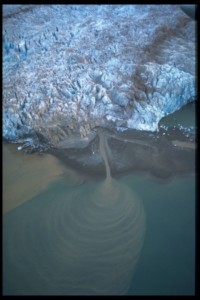Glaciers are getting smaller and are retreating
 Eroded material, like sand and silt, is being transported by a glacial river and deposited in the fjord. As a glacier gradually grows, it excavates into the ground beneath, picking up rocks, sand and gravel so that its lower side becomes like a gigantic sheet of sandpaper. When the glacier moves forward, this sandpaper scrapes the ground beneath, grinding material loose from even the very hardest of rocks. If water is added to lubricate this grinding process, it proceeds even faster. Running water between the sole of the glacier and the bedrock acts as a lubricant for the glacier. The glacier glides faster, the erosion gets stronger and more material is deposited in front of it or is carried into the sea by glacial rivers.
Illustration: Bjørn Frantzen, NPI
Eroded material, like sand and silt, is being transported by a glacial river and deposited in the fjord. As a glacier gradually grows, it excavates into the ground beneath, picking up rocks, sand and gravel so that its lower side becomes like a gigantic sheet of sandpaper. When the glacier moves forward, this sandpaper scrapes the ground beneath, grinding material loose from even the very hardest of rocks. If water is added to lubricate this grinding process, it proceeds even faster. Running water between the sole of the glacier and the bedrock acts as a lubricant for the glacier. The glacier glides faster, the erosion gets stronger and more material is deposited in front of it or is carried into the sea by glacial rivers.
Illustration: Bjørn Frantzen, NPI
Why?
Research shows that the glaciers in Svalbard are melting and getting smaller. This is taking place because the climate has become generally warmer in the past 100 years. Higher air temperatures have brought a more rapid retreat in the last 10 years.
A glacier gets smaller because it loses more mass during the summer than it adds in the winter. It is mainly temperature and precipitation that control this relationship. Measurements of the mass balance in three glaciers in Svalbard show that two of them, which are in the lowlands, had a negative mass balance from 1967 to today, whereas the third, which is situated higher up, had a positive mass balance until 2000, but it, too, has had a negative trend since then.
What is taking place?
Melting sea ice does not raise the water level, but ice – glaciers – melting on land does. Forecasts show that a possible total melting of the major ice caps in the Antarctic and Greenland will give the greatest change in sea level, but in the near future it is expected that the total melting of smaller glaciers, like those in Svalbard, will contribute most to a rising sea level. It has been calculated that the sea may rise by up to one metre along the coast of Norway in the coming 100 years.
The ocean currents may be affected in extreme cases if the glaciers melt particularly rapidly, but the present-day melting is not strong enough for that. On the other hand, increased runoff of fresh water to the sea may affect the animal life. Several plankton organisms are sensitive to changes in salinity, and changes caused by meltwater may alter the species composition and, hence, the food available for several organisms in the region. This type of change also occurs in response to the melting of sea ice, but melting of glaciers generally generates very dramatic changes because very sudden outpourings of large amounts of meltwater may ”suffocate” the micro-organisms in the sea.
As meltwater forms on the glacier surface, it gradually finds its way down to the glacier sole along channels in the ice. The water beneath the ice lubricates the subsurface causing the glacier to glide faster, which increases the calving of icebergs and results in more mass disappearing into the sea more rapidly. Erosion takes place when ice moves over the underlying bedrock. The eroded material is transported to the sea by rivers and is deposited on the floor of the fjords. There is normally little life closest to the glacier, but if sediments build up very rapidly on the sea floor, they may bury the living organisms further out in the fjord, too. If several eroding glaciers enter the same fjord, an entire fjord ecosystem may be noticeably altered.
Did you know...
 Svalbard glaciers are not only retreating, they are also getting thinner. Measurements show that they are losing between 60 and 70 centimetres of their thickness each year. As the amount of ice that is weighing Svalbard down is declining, the land is rising. This land rise is not particularly rapid, but it is actually measurable with modern instruments.
Svalbard glaciers are not only retreating, they are also getting thinner. Measurements show that they are losing between 60 and 70 centimetres of their thickness each year. As the amount of ice that is weighing Svalbard down is declining, the land is rising. This land rise is not particularly rapid, but it is actually measurable with modern instruments.